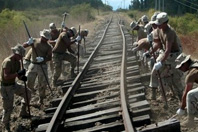By Tim Padgett
In Chile’s second largest city, ConcepciÓn, the army has issued a “silence” order on some urban blocks so rescue workers can hear the possible tapping of survivors under the rubble of the massive 8.8-magnitude earthquake that hit the country on Feb. 27. The quake may be, as Chilean President Michelle Bachelet said on Sunday, “an emergency unparalleled” in the country’s history. But the death toll – fewer than 1,000 so far, despite the quake’s being one of the strongest ever recorded – is a tribute to Chile’s remarkable preparation and response.
Remarkable, that is, in terms of coping with what happened on land. Disaster officials now say the majority of Chile’s fatalities may have resulted from the temblor-generated tsunami waves that slammed coastal towns like ConstituciÓn, where 350 people were killed. And that points up the only area in which Chile and its government may have fallen short in this disaster.
If so, it’s a perplexing misstep by a country that has seen what kind of tsunami an earthquake this strong can hurl – as it did in 1960, when a 9.5-magnitude quake, the most powerful ever recorded, killed more than 1,600 people. Inexplicably, in the minutes after Saturday’s quake, Chilean officials told coastal communities like ConstituciÓn that there was little if any danger of tsunamis. Chilean television networks later aired video of tall, destructive waves pushing houses, cars and boats through fishing villages. “We ran desperately up the hill and watched how the sea washed everything away,” a woman in the village of Duao told a Chilean-TV reporter. The wave that hit the village of Talcahuano rose more than 7½ ft.
Bachelet’s government has suggested it was working with flawed data from its navy. Scientists say a tsunami’s likelihood and force depend largely on the amount of vertical movement an earthquake causes at the sea floor. The 9.0-magnitude quake that caused the devastating South Asia tsunami of 2004 yielded potent vertical displacement of about 16 ft. (5 m); Chile’s Saturday temblor, centered just off the Pacific coast about midway between the capital, Santiago, and ConcepciÓn, is thought to have involved significant vertical motion as well. Fortunately, no other countries in the Pacific Basin were affected by the Chile tsunami. “But it’s hard to understand how the Chileans didn’t foresee a major tsunami, at least for its own coast so close to the epicenter,” says a U.S. geologist who asked not to be identified because he is still studying the Chile data. “Not only was this one of the most powerful earthquakes we’ve seen in years, its movement was mostly vertical, which produces the most dangerous tsunamis.” (See how Asia recovered from the 2004 tsunami.)
But Jane Lubchenco, head of the National Oceanic and Atmospheric Administration in Washington, which is analyzing the Chile tsunami data, says that precisely because the communities were so close to the epicenter, tsunami waves arrived “almost instantaneously.” (Most accounts indicate they hit the shore less than 20 minutes after the first quake shock.) “It would have been virtually impossible to mobilize quickly enough to get out of harm’s way,” Lubchenco says – especially at 3:30 a.m., when the quake hit. “They didn’t have the benefit of early warning in this case.”
Ricardo Zapata, a disaster-evaluation chief for the Santiago-based Economic Commission on Latin America and the Caribbean (ECLAC), cites three levels of damage in the Chile quake. The first was the collapse of older, pre-1960 buildings, many of which were further damaged because they were constructed too close to one another. The second was the failure of newer buildings like ConcepciÓn’s apartment high-rises, which, while not pancaking like poorly built structures did during Haiti’s 7.0-magnitude earthquake on Jan. 12, in many cases tilted over and broke, because even the strongest foundations can experience a kind of liquefaction by vibration in such powerful temblors. The last was the tsunami wreckage – and if early reports are true that it caused the most deaths, says Zapata, “that’s something the Chileans are going to have to take a long, hard look at.” (See why Chile’s earthquake wasn’t unexpected.)
Still, says Zapata, who is heading up ECLAC’s evaluation of the Haiti quake, “given the intensity of Chile’s earthquake, it’s amazing that there haven’t been more damage and deaths than what we’ve seen so far.” Chile has been credited with mandating strict building codes. But even the best earthquake-fitted infrastructure would have trouble withstanding magnitudes much higher than 8.0. The Chile quake, Zapata says, “is off the charts no matter how you look at it,” which is why so many bridges and roads have been destroyed there. (See the top 10 news stories of 2009.)
Chile’s death toll could eventually rise above 1,000. But right now, aside from the rescue process, the biggest issue on the ground is the top priority for any earthquake-battered country: getting food, water and medical aid to the hardest-hit zones. Rescuers were hampered in ConcepciÓn over the weekend by tear-gas smoke fired at grocery-store looters – an embarrassing scene that prompted Bachelet to arrange for vendors to give free food away.
Bachelet, a moderate socialist who remains remarkably popular in Chile, hands her office to conservative President-elect SebastiÁn PiÑera on March 11. She is expected to ask U.S. Secretary of State Hillary Clinton for a relatively small amount of American aid when Clinton visits Chile on Tuesday during her previously scheduled tour of Latin America this week. Clinton will no doubt praise Bachelet’s leadership during the emergency – as most Chileans have, despite the apparent tsunami mishap. It will be up to PiÑera to put mechanisms in place to make sure Chile is as prepared at sea as it is on land when the next earthquake strikes.









